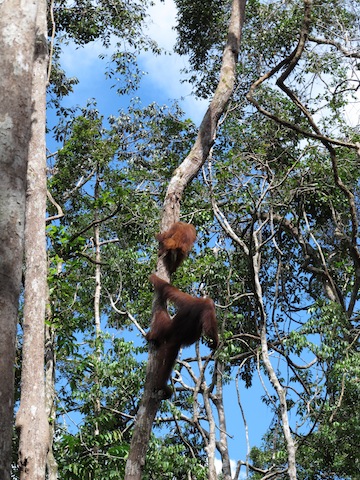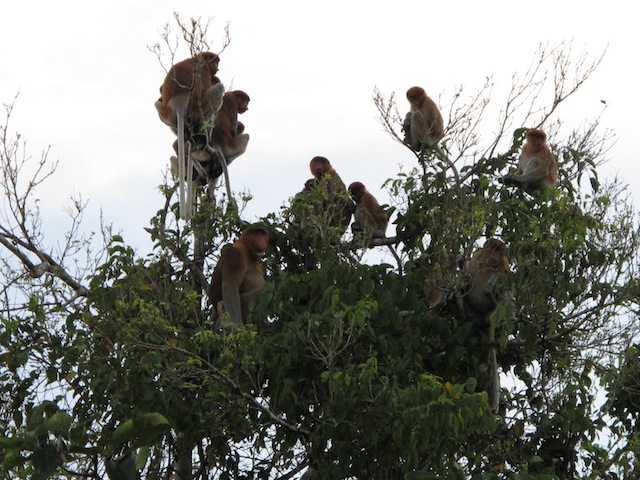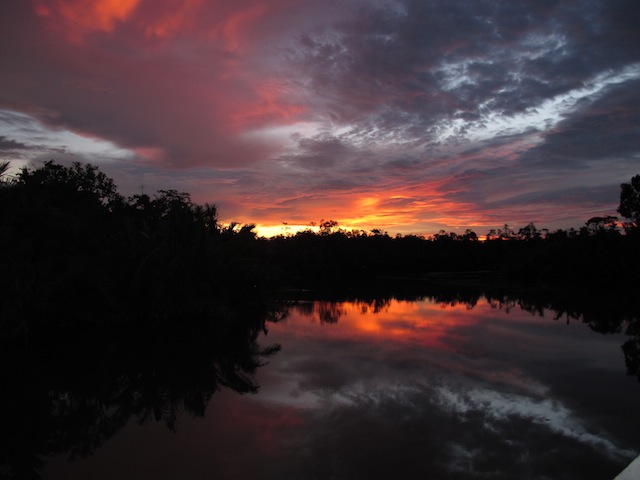In the third and final part of this series, writer Simon Pridmore sums up his experience in Kalimantan's remote Tanjung Puting National Park.
The Verdict
The two-story 'kelotok' is a great way to explore Kalimantan
A slow boat trip through Tanjung Puting provides a wonderful opportunity to enjoy the natural beauty of the Borneo forest and watch the behaviour of the primates that inhabit it.
It also allows the visitor to experience a number of the major issues facing Indonesia.
Given Indonesia’s awful environmental record, you might expect the verdict on what we observed to consist of a litany of damnation, but there is both good and bad news.
Let's start with the bad . . .
The Bad News
1) Illegal Activity
Park tours all begin from Kumai, which receives the bulk of tourism's financial benefits. The eastern half of Tanjung Puting National Park lies in a separate regency and does not benefit at all from park tourism. Unsurprisingly, the authorities there are more vulnerable to the solicitations of illegal loggers, miners and palm oil planters keen to turn forest into “productive” land.
One result of this is that the Sekonyer River is a health hazard, its waters polluted by chemical runoff from small-scale mining and logging activity upstream. The activity is widespread and uncontrolled. The miners are not large companies with industrial machinery but small landholders who dug for gold in the past. Now that the gold is gone, they extract silica for the computer chip industry.
2) Poor Facilities
The poor state of Camp Leakey and the increasing number of visitors presents a conflict that needs to be resolved. While, for now, tourists may be satisfied with the feeding time shows, eventually the lack of maintenance evident in missing walkway planks and the disregard for visitor comfort, could lead to declining numbers.

Unlike humans, an orangutan's armspan is considerably greater than its height . . . about 2 meters from fingertip to fingertip, but only 1.5m from head to toe.
This may particularly be the case with high-rolling operations such as the Orion, whose guests pay about US$1000 a day for their Borneo Adventure cruises. They may not understand why the money they pay cannot be used to build safe, well-maintained facilities.
Without tourists, the guides and feeders will find work elsewhere, illegal activity may push further into the Park and the orangutans could find themselves under threat as they are elsewhere in Kalimantan. The Tanjung Puting population might be even more vulnerable than groups elsewhere because many are not afraid of humans. They should be!
3) Threats to the orangutans
Palm oil plantations in Kalimantan have encroached to such an extent on the habitat of the orangutans that they often come out from the forest to feed on young palm saplings. Just one orangutan can destroy 100 trees a day. Plantation managers treat them as pests, offering bounties of up to IDR 1 million (a little over US$100) for each animal delivered dead or alive.
The Good News
1) Tourism seems to be beneficial to the orangutans
Poor though the Camp Leakey facilities may be, it seems that the orangutans in Tanjung Puting are thriving. The large number of females we saw with babies on board points to a healthy population capable of surviving independently with the addition of the little treats supplied at the daily tourist feedings. The increasing number of local people involved as guides, boat crew, feeders and travel agents and whose livelihood depends on orangutan tourism provides the orangutans with a burgeoning population of human beings with a vested economic interest in their protection and survival. It is encouraging that the involvement of the orangutans themselves is voluntary, if slightly coerced by buckets of bananas! It was also good to see the enforcement by the guides of the “no contact” rule to prevent the passage of disease from human to animal and vice versa.
2) Tourist impact on the forest is gentle and minimal
The impact made by visitors on the Park is tiny. Only a few tracks wind off into the forest between riverside encampments and the platforms and just three feeding places are currently active. Camp Leakey is the busiest. Only those visitors like us on multi-day trips frequent the other two. Apart from the kelotoks, river traffic consists mainly of fishermen, palm leaf harvesters and speedboats going back and forth between Kumai and the mining concessions. We did see some suspiciously straight canals branching off the river through the peat but most of these were overgrown and on the northern (non-Park) side of the Sekonyer.

A tribe of proboscis monkeys usually includes 1 male and up to 7 females
Conclusion: Visit Tanjung Puting! But please tread gently, take only photos, leave only footprints and say HI to the orangutans for me while you're there.

Related Articles:
"Kalimantan Primates: Visiting Kalimantan's Tanjong Puting National Park" (Part 1)
"Camp Leakey and Kalimantan Orangutans" (Part 2)
Photo Credits: Simon Pridmore
